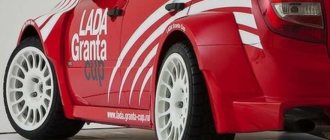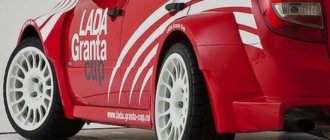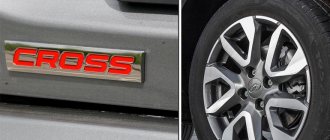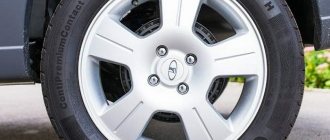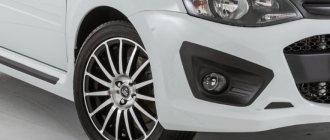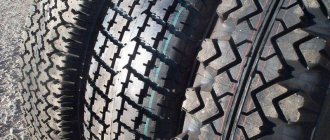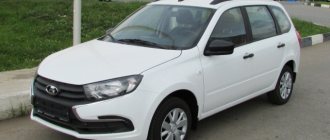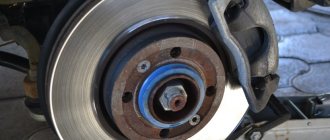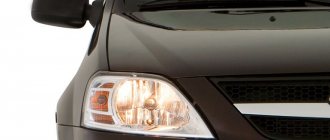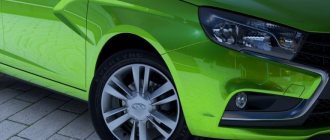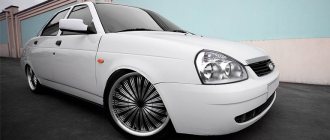Tire size is one of the most important parameters that can significantly change the behavior of a car on the road. In our review we will tell you about the permissible tire size on the Grant, as well as what the size of the tires affects during the operation of the car. Let's start with the tire and wheel sizes allowed by the manufacturer.
Old family (until 09.2018)
Sedan
:
| Equipment | Tire size with load capacity and speed indexes* | Disc size | |
| rim width (inches) | rim offset (ET), mm** | ||
| Standard | 175/70 R13 82T, N | 5J | 35 |
| Standard Norm Lux | 175/65 R14 82T, N 185/60 R14 82T, N 185/55 R15 82T, N | 5J, 51/2J, 6J | 35 |
| Sport | 185/55 R15 195/50 R16 | 5J, 51/2J, 6J | 35 |
R is not a radius, but a designation of the radius of the tire, and the number is the diameter of the rim in inches.
Liftback
:
| Equipment | Tire size with load capacity and speed indexes* | Disc size | |
| rim width (inches) | rim offset (ET), mm** | ||
| All modifications | 175/65 R14 82T, N 185/60 R14 82T, N 185/55 R15 82T, N, V | 5J, 51/2J, 6J | 35 |
- * Speed indices: T – up to 190 km/h, H – up to 210 km/h, V – up to 240 km/h. Load capacity indices: 82 – 475 kg.
- **Rim offset (ET) is the distance from the mating plane of the disc to the middle of the rim.
Wheel hub bolt pattern 4x98, DIA - 58.5.
Factory tire pressure parameters LadaGranta
The pressure in the grant tires of the basic factory configuration, namely R13 and R14 at partial load looks like this: R13 (175/70) - 0.19/0.19 (1.9/1.9) R14 (175/65) - 0 .20/0.20 (2.0/2.0) Data are presented in the ratio “kg/cm2”. The pressure in Grant Sport tires is approximately at the same level, adjusted for the dimensional characteristics of the wheel, namely R16.
What other tires and wheels are suitable for the Grant?
A survey was conducted among VKontakte users, asking them to choose alloy wheels for Granta. 42% of participants recommend installing R15 wheels on the Grant. 27% chose R14. Third place (17% of voters) believe that 16 wheels on Grant will look best. The left tire compatibility table is built for 175/70 R13, and the right one is for 185/55 R15:
Green indicates the minimum deviation of the wheel diameter (up to 3 mm); Orange indicates a diameter deviation from 3 to 6 mm.
Based on reviews from owners, we have compiled a list of compatibility of Lada Granta tires and wheels:
- R14 wheels on Granta can be installed with the following tire parameters: 175/60 R14, 175/55 R14, 175/50 R14, 175/45 R14, 175/40 R14, 185/55 R14, 185/50 R14, 185/45 R14 , 185/40 R14, 195/50 R14, 195/45 R14, 195/40 R14, 205/55 R14, 205/50 R14, 205/45 R14, 205/40 R14 and 205/32 R14.
- R15 wheels on the Grant are installed with the following parameters: 175/50 R15, 175/45 R15, 175/40 R15, 185/50 R15, 185/45 R15, 185/40 R15, 195/50 R15, 195/45 R15, 195/ 40 R15, 205/50 R15, 205/45 R15, 205/40 R15 and 205/32 R15.
- R16 wheels on the Grant are equipped with tires: 175/50 R16, 175/45 R16, 175/40 R16, 185/45 R16, 185/40 R16, 195/45 R16, 195/40 R16 and 205/32 R16.
- R17 wheels for the Grant (the same number voted for R13 wheels); it is recommended to install them with tires: 185/40 R17, 195/40 R17 and 205/32 R17.
Don't forget about the rim width:
When installing tires or wheels that differ in parameters
from those recommended by the factory, you can:
- be refused warranty repair of the chassis;
- be stopped by a traffic police inspector, who has the right to draw up a report on the car’s non-compliance with the requirements of the Technical Regulations;
- fail to pass technical inspection.
A short checklist - How to buy tires for the Lada Granta correctly
1. You should look for the right tires, keeping in mind the factory dimensional specifications. The size of the selected tires must match these data. 2. Pay attention to the tread pattern. Driving comfort largely depends on it.
3. Pay attention to the width parameters. The acceleration and braking of a car is affected by the width of the spot converging with the road surface. 4. Particular attention should be paid to the bore diameter. Tires that are excessively high or wide can damage the suspension, while tires that are too narrow will increase the load on the bearings. 5. It is important to consider the maximum speed index and load capacity index. 6. Treadwear, Traction, Temperature and MaxPressure data provide information on the tire's factory wear life, braking performance, temperature resistance and pressure limit for the tire respectively.
What does the size of tires and wheels affect?
| Increasing disc diameter | Increasing rim width | Increasing tire width | |
| Car style | will improve | will improve | will improve |
| Road holding | will improve | will improve | will improve |
| Steering precision | will improve | will improve | will improve |
| Tire grip | Will not change | Will not change | will improve, but only on dry roads |
| Resistance to hydroplaning | Will not change | Will not change | will get worse |
| Comfort on rough roads | will get worse | Will not change | will improve |
| Road noise | Will not change | Will not change | will intensify |
| Gasoline consumption | Will not change | will increase | will increase |
| Tire wear | Will not change | Will not change | will increase |
It is worth noting that it is better to choose winter tires for the Lada Grant as narrow as possible. Thus, the pressure of the car on the road surface will be greater, and therefore the grip on the road will improve. Also, do not forget that wide tires are more sensitive to the ruts on the road, and low-profile tires will transfer even the smallest bumps to your butt.
The smaller the unsprung masses
(this includes a lot of tires and wheels), the better the car will hold the road and accelerate faster. For example, if you put wheels on a car that are 2 kg lighter each, then acceleration to 100 km/h will be reduced by 0.2 seconds.
Attention! Installing larger wheels may lead to problems with ABS and ESC calibration (the systems may not work correctly).
Let us remind you that for safety and to increase the service life of your tires, you should maintain the recommended pressure in the Lada Granta tires.
Where can I buy
: in our online store (category Discs for Grants).
Keywords: Lada Granta wheels | Lada Granta tires | Lada Granta Sport
2 0 0 1 1 0
Share on social networks:
Winter tires on Lada Granta
Now let's see which winter tires to choose for the Lada Granta:
Viatti Brina Nordico
A relatively new model, developed by the German Continental together with Italian engineers, and put into production at the facilities of the Nizhnekamsk tire plant.
An asymmetrical tread pattern, a combination of middle blocks with rows of studs along the edges and variable sidewall stiffness technology ensure safe movement and stability when cornering and when crossing uneven roads.
Toyo Observe Garit G3-Ice
Winter tires from the Japanese Toyo are deservedly considered one of the best. If previously only sellers and those who drove it knew about this, then a test carried out at the test site not so long ago left no doubt.
Observe Garit G3-Ice tires competed with the Finnish Hakkapeliitta-7, slightly inferior to it in snowy areas and taking the lead on the compacted track. Experts believe that the whole point is in the studs, which protrude beyond the surface of the tire by 1.2 mm more than normal.
Goodyear UltraGrip 600
Another new product. Atypical tread pattern - as is the case with all Goodyear models. Looking at it, you get the impression that a solid wheel is simply cut into grooves. They provide the tire with excellent handling in loose snow.
Another distinctive feature is the hexagon-shaped studs, which make it possible to quickly accelerate and brake safely.
Hankook W429 i Pike
Winter studded tires of different generations from the Korean manufacturer Hankook have long established themselves as an excellent combination of price and quality. The latest model has been slightly redesigned; the shape of some tread elements has slightly changed, although the symmetry of the pattern and directionality have been preserved.
Massive blocks on the sides replaced narrow ribs, and the tire began to work better in icy conditions.
The best models for summer
Now let's present several worthy summer models:
Bridgestone Ecopia EP150
The tread of this Japanese tire is developed using a new technology (NANO-PROTECH), which makes it possible to reduce the coefficient of rotational resistance and, as a result, save fuel consumption. Plus, the EP150 turned out to be lighter in weight and almost silent.
Nitto NT860
Another Japanese tire produced in Malaysia. Very soft rubber, perfectly balanced and brakes, thanks to the deep tread, self-cleaning from dirt and snow. With all this, the best thing is the low price.
Kormoran Impulser B2
Serbian Kormoran was developed using Michelin technology. The tire is stable when driving at speed, does not “float” if it gets into a puddle, has excellent grip on the road and is controlled when cornering.
Matador MP 47 Hectorra
The new generation summer tire from Slovenia MP-47 Hectorra performs excellently on both dry and wet surfaces thanks to its asymmetrical pattern with four deep longitudinal grooves.
Tread elements are optimized to the maximum, which improves acceleration and braking efforts and reduces noise levels.
Conclusion
Which winter tires are best for a car, or what to put on it for the summer, is, of course, up to the owner to decide. It all depends on what climate zone you have to use the car and what roads you drive on. And our information is designed to understand the characteristics of certain models and the advisability of their use.
Selection of tires by model
Knowing the size of the “shoes”, all that remains is to choose the style. Any car should have two sets of tires: winter and summer. Winter tires are installed without waiting for frost, but when the thermometer regularly drops below +5 degrees.
To save on the purchase of winter tires, some drivers make the mistaken decision to drive all-season tires. Therefore, we will make a small digression and explain why this should not be done.
When and what tires are needed for a car?
Let’s say right away that there are no tires that behave stably in any conditions. Why then is the tire called all-season? Because of the tread, which must have a deep relief and grooves through which water, dirt, and slush can easily pass.
All-season tires are tires that are comfortable to drive in the off-season, when the air temperature varies from +7 to -10 degrees. It is often marked M+S (mud/snow), which confuses many.
But in fact, an all-season tire is a summer tire and is not suitable for year-round driving, even in the southern regions of the country.
- All mud tires, and all winter tires, have an all-season tread. The only difference is in the rubber composition, which is designed for positive or negative wheel operation. On a winter tire, for better grip on icy roads, many thread-like sipes are made, which distinguishes it from all-season tires.
- Studless winter tires are popularly called Velcro. On such tires, the car feels great in icy conditions, but when the temperature outside is consistently positive (above +6-7 degrees), it must be changed to summer shoes.
- Winter tires are much softer, so if you try to drive them in the summer, they will wear out quickly. Studded tires are better suited for driving on snow, so when in winter you have to drive not on cleared asphalt, but on a country road, it is better to give preference to studded tires.
- All year round, all-season vehicles are driven mainly by trucks and buses, on which changing wheels is a labor-intensive process, and besides, there are usually more than four of them. True, in severe frosts and snowfalls they have a hard time riding on such tires.
And another important factor is for those who spend a lot of time driving. A tire for winter use is much softer than a summer one, but it is also noisy when driving, especially the studded one.
The summer one, and it is also an all-season one, in severe frosts “steals” and just rattles. And this is not to mention the fact that you will not so much ride on the ice as perform figure skating.
General background information
Tire and wheel sizes for Lada Priora 2012
Ranges of possible values for tires and wheels Lada Granta Cross 2020.
Tires
| Diameter | 15″–15″ |
| Width (mm) | 195–195 |
| Profile (%) | 55–55 |
| The smallest size | 195/55 R15 |
| The biggest size | 195/55 R15 |
Wheel disks
| Diameter | 15″–15″ |
| Width (inches) | 5.5–6 |
| Reach (mm) | 33–33 |
| Drills | 4×98 |
Photo
Expert advice
When choosing tires for a car, you must first follow the manufacturer's instructions. Ask yourself a few questions.
- On what roads will the car be primarily used?
- Do you need increased cross-country ability?
- How much of the route will be city roads and how much will be highways?
- Will the vehicle carry heavy loads?
The answers to these and similar questions will help determine which tire parameters you need to pay special attention to.
How to choose the right wheels for Lada Granta Cross 2022?
3 types of rims:
- Stamped (economical price category) - made from a sheet of iron by stamping on a press.
- Light alloy - manufactured by casting (more reliable than stamped ones).
- Forged (the highest quality and more expensive than the previous ones) - made from light alloys by stamping at high temperatures.
The choice depends on financial capabilities. However, it should be borne in mind that the quality of the road surface on which you have to drive every day must also be taken into account.
So, if it gets into a hole, a stamped disk will bend and will not cause harm to the tire, but a forged or cast one can cut it. There is a possibility that the cast disc may burst or crack.
It should also be noted that repairing “stamping” wheels is cheaper than repairing cast or forged wheels. But wheels with high-quality cast and forged disks kill the suspension less, because lighter and have more perfect geometry (better balanced).
The same wheels may or may not rub with tires on the same car - wheel alignment adjustment will help here.
What is the tire pressure?
It is the driver's responsibility to constantly monitor tire pressure. This will avoid standard problems associated with vehicle operation. An abnormal pressure value often causes:
- deterioration of management;
- uneven tread wear.
Often the car owner independently reduces the pressure in the wheels of his own vehicle. This reduces the load on the suspension, and the car “passes” various road irregularities an order of magnitude easier. But it is worth noting: a decrease in pressure even by 0.1 MPa leads to serious problems. The main ones include:
- increased fuel consumption;
- rapid wear of the outer tread segments;
- the car becomes less maneuverable.
An overinflated wheel causes no less problems. The central part of the cylinder begins to wear off quickly. In addition, at ambient temperatures of more than 60 degrees Celsius, the tire may simply explode. Which will lead to driving into the oncoming lane.
What is the tire pressure
Tire pressure is a relative value, but for tires of different sizes it should be almost the same. The pressure indicator does not mean the amount of air, but the ratio of air in the tire to its total volume.
According to the factory parameters, the pressure in R13 tires should be 1.9 atmospheres, while for R14 and R15 tires the pressure must be maintained at two atmospheres.

